Unsure about your French table manners? Click Here to download > > How to avoid these 10 food etiquette mistakes !
- Home ›
- Destinations ›
- Southwest France ›
- Biarritz
Things to Do in Biarritz If You Love History and Culture
Published 19 August 2025 by Leyla Alyanak — Parisian by birth, Lyonnaise by adoption, historian by passion
There are many things to do in Biarritz beyond sunbathing or learning to surf. As one of the gateways to France’s Basque Country, you'll find Belle Époque architecture, lively markets and deep-rooted Basque food traditions. This article highlights the best things to do in Biarritz if you love culture and history.
There's something in the air in Biarritz... I've felt it since I first stepped into this town with my parents so many years ago.
Recently, I returned, and the same something was still there — a blend of sharp perfume emanating from genteel little old ladies, the gentle patter of bare feet from surfer dudes, and salt thickened air and sunsets that could match those over the South China Sea.
It's hard to believe that this once modest fishing village became a year-round magnet for the glitterati of not one, but two eras – the Second Empire and the Belle Époque.
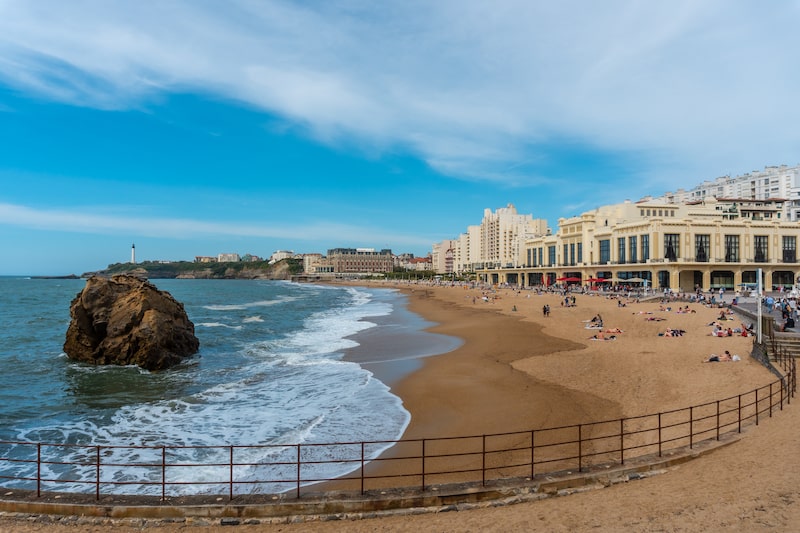 Biarritz today
Biarritz todayNOTE: Pages on this site may contain affiliate links, which support this site. See full Privacy Policy here.
Biarritz basics
Biarritz has no shortage of places to visit, but if I had to prune my list to only include the most famous, I'd come up with these as Biarritz must-sees (a few less-famous ones are listed further down.)
One of the most pleasant things to do in Biarritz is simply to stroll along the 6km of beachfront, the promenade that swings around the coast, or up and down the hills.
As you walk, you’ll pass imperial villas, Art Nouveau façades and Belle Époque cafés — reminders that this was once a royal and aristocratic playground.
La Grande Plage
My favorite beach is the Grande Plage, and I don’t tire of admiring the Art Deco casino that stands at the top of the beach. Just sit and sip a drink or coffee and wait for the sunset, watching the waves, a paradise for surfers but less welcoming for the average swimmer.
Several surf schools operate here, making it a good spot for beginners. At sunset, all the surfers make their way out of the ocean, surfboards under their arms, squeezing every last second of daylight from the sky.
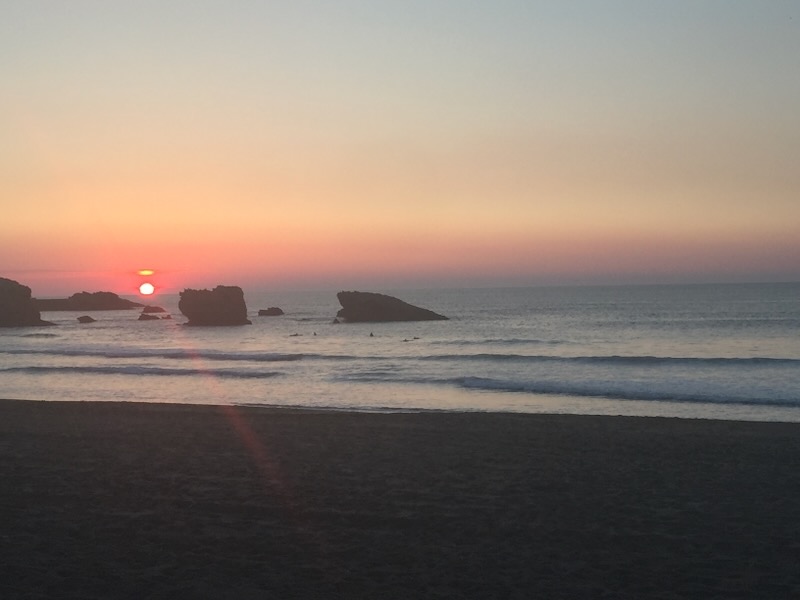 The Grande Plage at sunset ©OffbeatFrance
The Grande Plage at sunset ©OffbeatFranceRocher de la Vierge
This intriguing promontory can only be reached via a footbridge built by Napoleon III’s engineers. The Virgin statue, added in 1865, recalls local fishermen who survived a violent storm after praying for her protection. From here, you'll love the views that sweep across the Bay of Biscay and along the Basque coast.
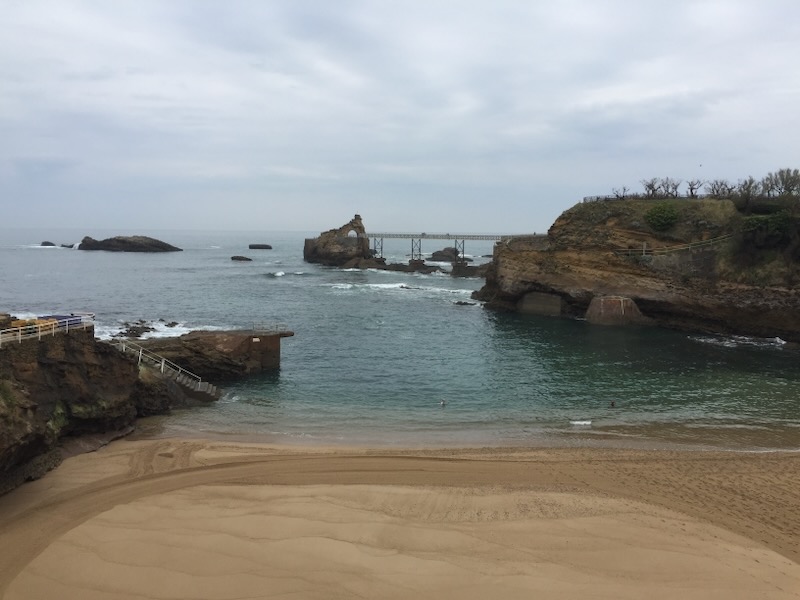 A cloudy day over the Rocher de la Vierge in Biarritz ©OffbeatFrance
A cloudy day over the Rocher de la Vierge in Biarritz ©OffbeatFranceBiarritz’s ocean-themed museums
The Musée de la Mer is housed in a 1933 Art Deco building facing the sea, and is a mix of local history and marine life, especially the town’s whaling heritage. A short distance away is the modern Cité de l’Océan et du Surf, which is more about ocean science and surf culture. Both are ideal for families, of course, but for everyone, especially on a hot summer day.
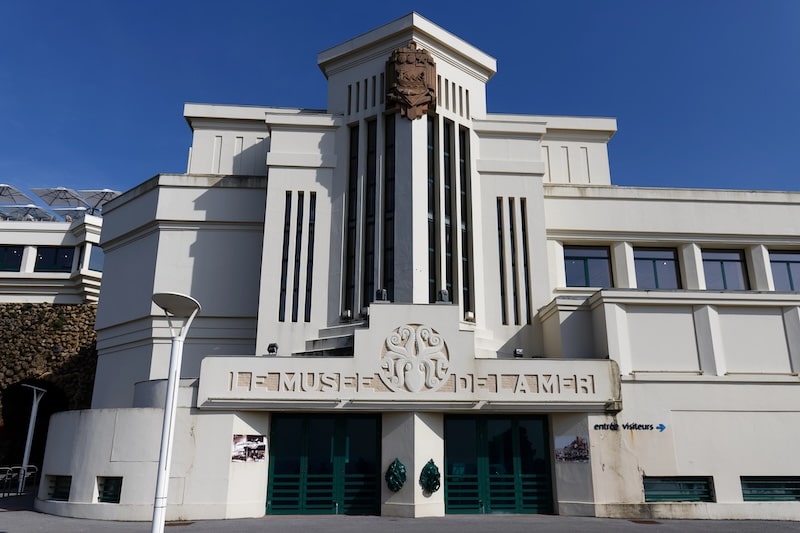 The fabulous Art Deco lines of the Musée de la Mer
The fabulous Art Deco lines of the Musée de la MerLes Halles de Biarritz
This happens to be one of my favorite Biarritz stops but I don't recommend it if you're on a diet. It's a large covered market known for its Basque specialties, from cured hams and sheep’s milk cheeses to espelette pepper products and fresh seafood stalls. If you're heading off on a picnic, this is THE place to fill your picnic basket.
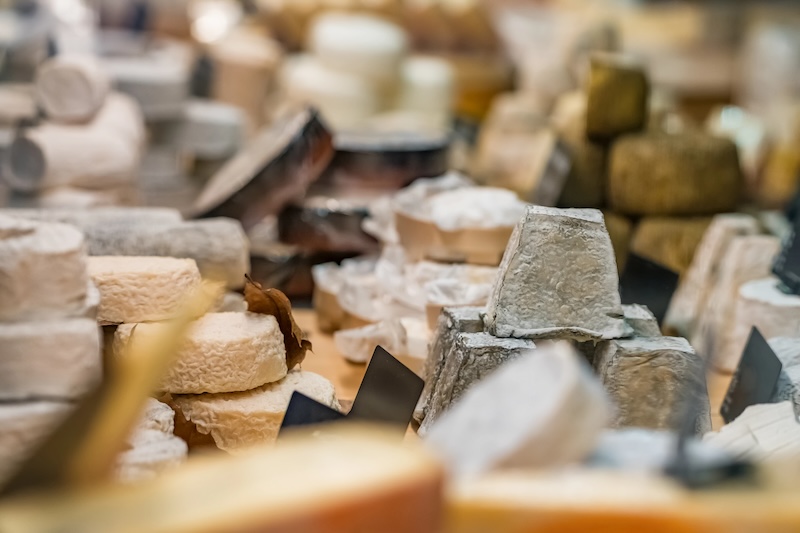 The wonderful cheeses of Les Halles in Biarritz
The wonderful cheeses of Les Halles in BiarritzIf you’re fond of Basque tapas — the pintxo, a slice of bread topped with various ingredients and pinned together with a toothpick — you’ll find several cafés around Les Halles. Half a dozen can fill you up as much as a light meal. Some pairings are surprisingly inventive, like chorizo, mayonnaise, anchovy, peppers, and olive, for example. Or plenty of simpler fare. Don't miss these!
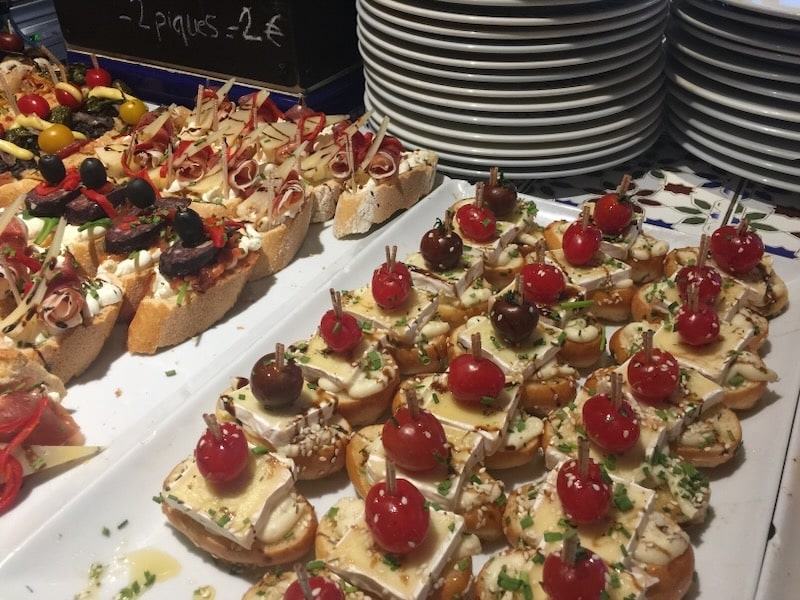 A typical display of pintxos in one of the bars near Les Halles in Biarritz ©OffbeatFrance
A typical display of pintxos in one of the bars near Les Halles in Biarritz ©OffbeatFranceWOULD YOU LIKE MORE BIARRITZ BACKSTORY?
Do you want a better understanding of what you're seeing?
Reserve one of these walking tours of Biarritz!
Lesser-known corners of Biarritz
Those were the classics.
If you’re curious about Biarritz’s past rather than just its scenery, head for the places that still carry the town’s imperial and Basque roots — from cliffside villas and historic harbors to a Belle Époque lighthouse and a Russian church.
Port des Pêcheurs
This is a small 19th-century fishing harbor tucked between cliffs. Lined with modest fishermen’s cottages, their doors and shutters painted typical basque colors, it’s now a quiet spot for a stroll and a seafood meal.
Phare de Biarritz
This amazing lighthouse dates back to 1834 and is at the northern tip of town, where the long sandy beaches of the Landes give way to the rugged Basque coastline. If you're feeling energetic and in the mood for some panoramic views, they're only 248 steps away.
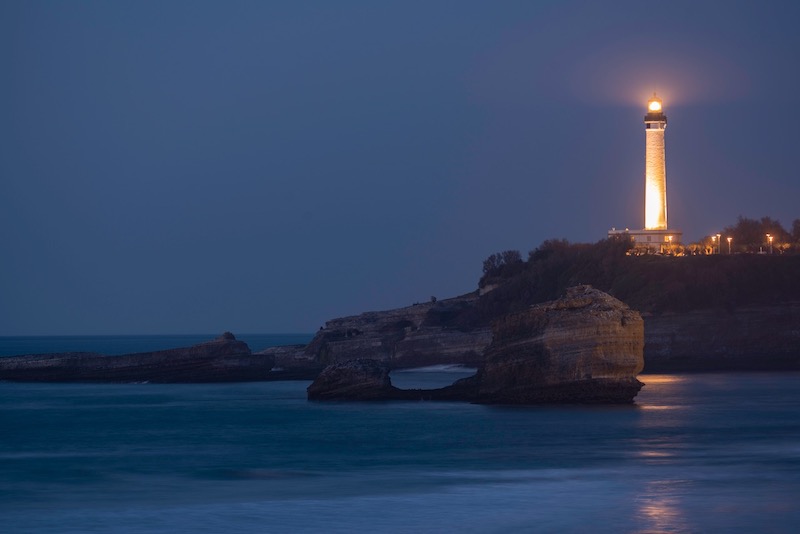 Biarritz lighthouse at night ©OffbeatFrance
Biarritz lighthouse at night ©OffbeatFranceRussian Orthodox Church
Why, you ask? Because during the Belle Époque, Biarritz was full of wintering Russian aristocrats. Now, its small, blue-domed chapel, consecrated in 1892, reflects the community’s émigré heritage.
Villa Belza
This late-19th-century Gothic Revival villa is one one of Biarritz’s most photographed buildings. Read its full story below.
THE VILLA BELZA
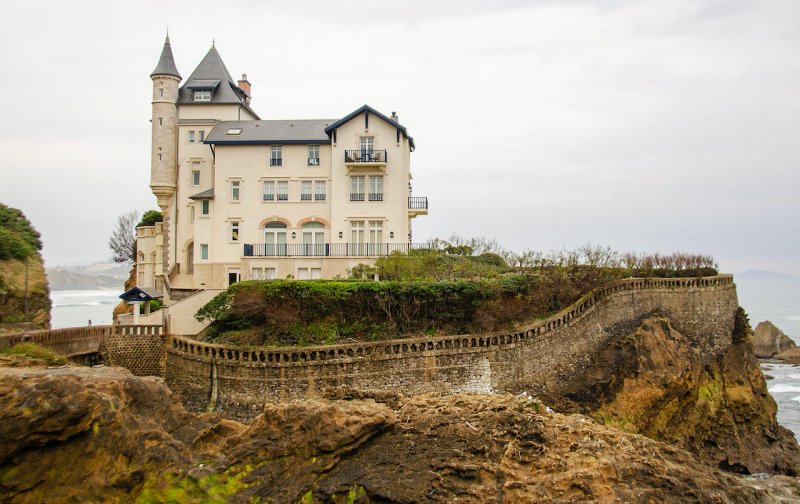
Doesn’t the Villa Belza look just a little bit haunted?
Doesn't the silhouette remind you of a certain movie that involved a knife, a shower curtain and a bit of bloodshed?
This neo-gothic villa may not be haunted, but it does have a chequered history. Built at the height of Biarritz’s popularity, it is one of many luxurious 19th-century architectural gems in the city.
It burned to the ground at least once (possibly twice), it starred in a movie (and was burgled as a result of that fleeting fame) and in 1923 it became a restaurant, the Chateau Basque, run by exiled White Russians. It was known for its wild parties for a while, eventually requisitioned by the Nazis during World War II.
It was transformed into condos but you can get a great view from either the Rocher de la Vierge, if you walk out to the outcrop, or from the little beach at Vieux-Port.
In Basque, ‘belza’ means black. It would seem the villa was named after the original owner’s wife, who in turn might have been named after a Caribbean governess who had saved the family’s children from certain death during the French Revolution.
Oh, and it might look less haunted on a sunny day.
Biarritz in summer
Biarritz is often called Europe’s surfing capital, and described as the “playground for all things surfing.”
The beaches in Biarritz, especially Plage de la Côte des Basques, draw surfers of all levels, with plenty of schools offering lessons and equipment rentals.
While working on the film The Sun Also Rises, screenwriter Peter Viertel — then married to actress Deborah Kerr — brought along his California surfboard. What began as a curiosity for onlookers soon became a spectacle, and the sport caught on so quickly that Biarritz would go on to claim the title of Europe’s surfing capital.
That's why you'll find around 20 surfing schools here, along with plenty of surf hostels and surf shops throughout town.
Summer is also festival time, like the Biarritz Surf Festival, adding music and cultural events to the rhythm of the waves.
Biarritz in winter
Biarritz isn’t only a summer destination.
The city has a long-entrenched spa culture, particularly thalassotherapy, which uses heated seawater for therapeutic treatments.
In winter, when the pace slows and the beaches grow quieter, spas offer a different way to enjoy the coast.
Biarritz is filled with chocolate, which is far more enjoyable in winter. Drop by Henriet for some originally designed bits or for my favorite, marzipan.
Empire and the Belle Époque in Biarritz
Before the Second Empire in France, that of Emperor Napoleon III and his wife Eugénie, this was a quiet whaling village. Its metamorphosis into a playground for European royalty was quick and spectacular.
It all happened because Eugénie fell in love with Biarritz — and where an empress went, the 19th-century elite followed.
When Eugénie first visited in 1854, the sea air reminded her of her native Spain. Napoleon III had a villa built for her on the dunes — the Villa Eugénie, later expanded into the Hôtel du Palais — and they started spending each summer here.
Their presence acted like a magnet: Europe’s crowned heads, aristocrats, wealthy industrialists, everyone wanted to see and be seen in Biarritz. Soon, the modest seaside town was dotted with grand villas and hotels, with casinos and places of entertainment to fill those hours not spent hobnobbing, bathing, or dining.
That glamor survived the fall of the Second Empire in 1870 and was revived during the Belle Époque, when new visitors — from Russian aristocrats to wealthy Americans — kept Biarritz at the heart of Europe’s social season, all of it made easier by the new roads and rail connections.
There's still a lot to see from those two eras... including...
Hôtel du Palais
Built in 1854 as Eugénie’s summer villa, it was later transformed into a grand hotel. Fully renovated recently, this is a luxury five-star stay you'll remember, for the setting and the pampering Empire-style, but also for the immense history it carries. You can reserve your room here.

Imperial Chapel
This was built specifically for Empress Eugénie and is worth a visit if you happen to be in Biarritz when it's open, usually one or two days a week – and you'll have to reserve. The architect was Paul Louis Boeswillwald, a student of Eugene Viollet-le-Duc, the influential restoration architect known for his work on Notre-Dame-de-Paris and Carcassonne.

Belle Époque villas
Many 19th-century houses survive in the streets behind the Grande Plage, with eclectic façades that hint at the era’s wealth and style. I say façades because most of them, like the Villa Belza or Villa Cyrano, are private residences and can't be visited. Villa Natacha is one of the few you can visit, since it now belongs to the city and hosts several municipal services. And there's always the Hotel du Palais...

Biarritz's Basque heritage
Biarritz’s culture is deeply tied to the Basque Country, and its markets, bakeries, and small workshops keep these traditions alive.
From historical pastries to artisanal footwear, you'll find evidence of its Basque regional roots all over town.
- Les Halles de Biarritz – This covered market was supplied for over a century by Basque farmers, cheesemakers and fishermen. Today you'll find delicious sheep’s milk cheeses, cured meats, pastries, and plenty of fresh seafood.
- Chocolate shops – Biarritz’s chocolate-making tradition dates back generations and you'll find plenty of choice at Henriet and Paries.
- Gâteau basque – This dense cake filled with pastry cream or black cherry jam is a Basque classic. Maison Adam and Miremont are among the best-known makers.
- Espadrille shops – This traditional canvas-and-rope shoe originated in the Pyrenees and has been worn across Basque Country for centuries. Small-scale production continues in Biarritz, with workshops such as Don Quichosse and Prodiso.
- Basque food – The Spanish side of the Basque Country has some of the best chefs in the world, so it won't surprise you that some of the best restaurants in Biarritz are world class. You'll find all types of cuisines here, but I truly enjoyed the Basque cuisine nearly everywhere I went.
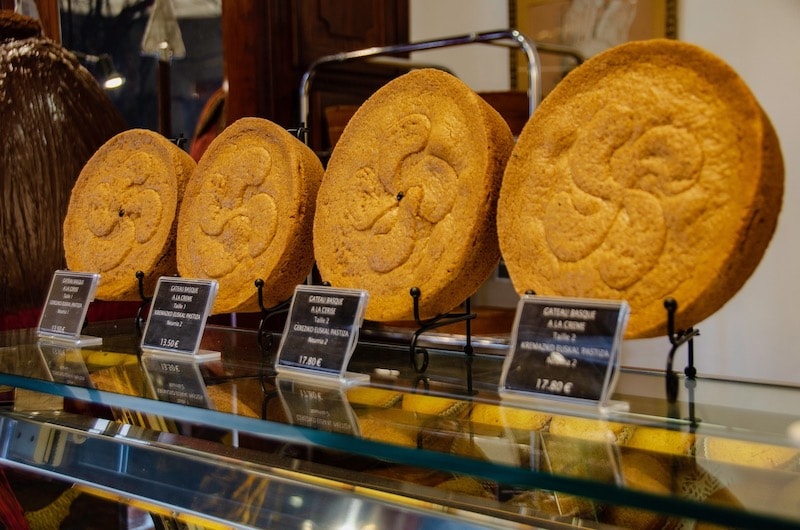 Delicious gateaux basques, typical of the rgion ©OffbeatFrance
Delicious gateaux basques, typical of the rgion ©OffbeatFrance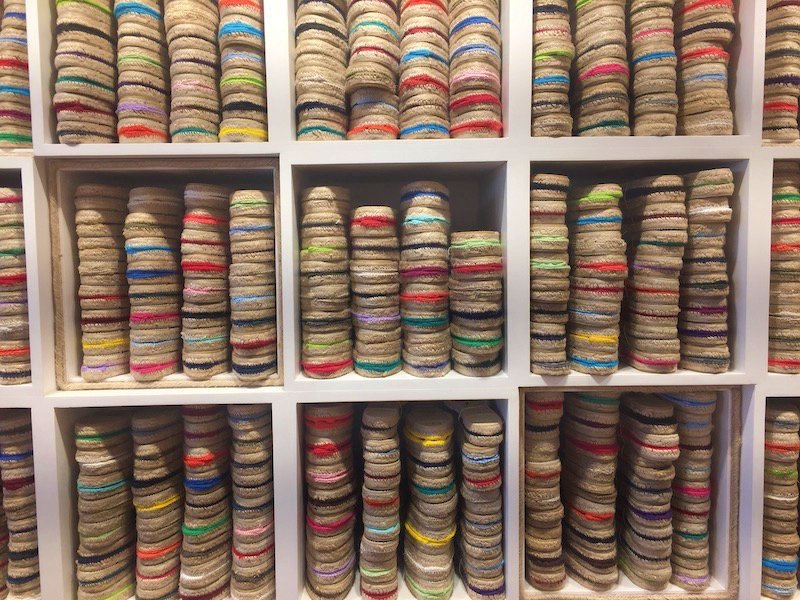 Locally produced espadrilles, still very much used today
Locally produced espadrilles, still very much used today Cheese shop in the Halles de Biarritz
Cheese shop in the Halles de BiarritzDay trips from Biarritz
Part of the interest of Biarritz is its central location. You can be over the border in Spain, San Sebastian specifically, in under an hour's drive.
THIS ONE-DAY SPANISH EXTRAVAGANZA TAKES YOU TO...
- San Sebastian
- Bilbao
- The Guggenheim Museum
- Lunch in a pintxos bar
Get picked up in Biarritz or Bayonne and spend the day in the Spanish part of the Basque country.
Within France, there's also plenty to see in a day.
Here are a few suggestions:
- Bayonne – former port for whale oil and cod, later famous for chocolate-making introduced by Jewish refugees from Spain and Portugal in the 17th century
- Saint-Jean-de-Luz – fishing port with both pirate and royal wedding history, site of Louis XIV’s wedding to the Spanish Infanta in 1660
- Hendaye or Hondarribia, Guethary or Bidard – Basque towns along the coast
- Anglet – go to the spa for the day, or visit my favorite art gallery, Art Traffik
- Basque country interior – because it's so close to the coast, there are several places you can easily reach in a day; pick and choose from this one-week road trip itinerary
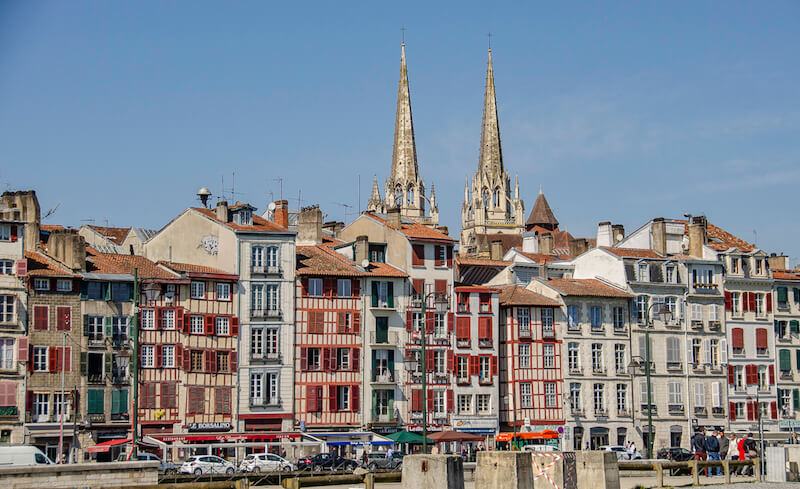 Typical houses of Bayonne ©OffbeatFrance
Typical houses of Bayonne ©OffbeatFrance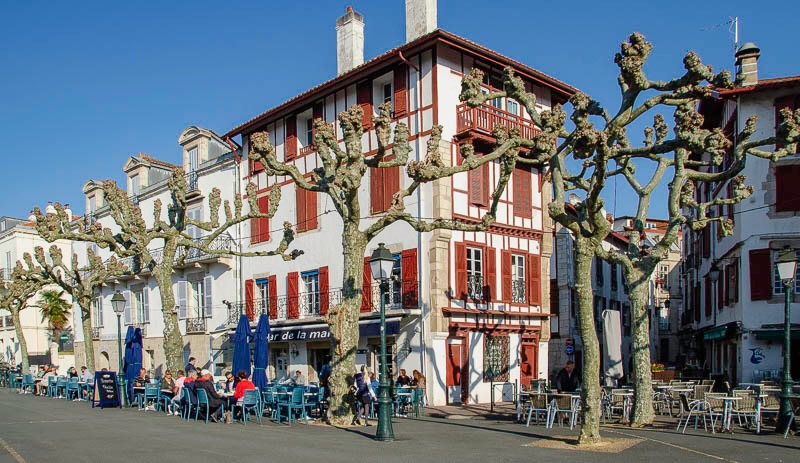 A winter view of Place Louis XIV in Saint-Jean-de-Luz ©OffbeatFrance
A winter view of Place Louis XIV in Saint-Jean-de-Luz ©OffbeatFrance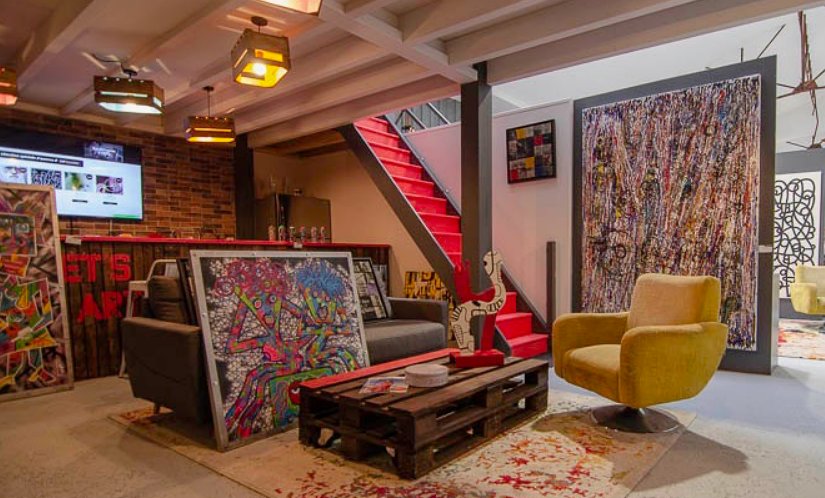 Art Traffik in Anglet, my favorite art gallery ©OffbeatFrance
Art Traffik in Anglet, my favorite art gallery ©OffbeatFranceTips for your Biarritz trip
Getting to Biarritz and getting around
The nearest train station is Gare de Biarritz, about 3 km from the center (you can buy your train tickets here).
Local buses and taxis connect the station with the beach area. Biarritz also has a small airport with flights from Paris and other European cities.
The center of town is compact and walkable, but local buses – especially the free shuttle – cover nearby beaches and neighborhoods and are frequent (and electric).
For day trips into the Basque Country, regional trains and buses are available with the Txik Txak public transportation network.
Where to stay in Biarritz
- Upmarket: Hotel du Palais, for unbridled luxury – Empress Eugenie’s former home
- Mid-range: Café de Paris, right at the top of the Grande Plage – can’t beat the views
- Budget: La Maison du Lierre, utterly charming and in the very heart of Biarritz or Hotel Jules Verne, modern and with plenty of parking across the street if you're coming by car
Before you go...
If this has sparked your interest in the French Basque country, don’t stop at Biarritz.
You’ll find plenty more to explore in the rest of the region, from the chocolate traditions of Bayonne to the fishing ports (and royal wedding history) of Saint-Jean-de-Luz.
If you'd like to know more about French and Basque history, you might enjoy my recent Substack story on the Paix des Dames — a dramatic hostage exchange and peace treaty that took place just a few kilometers south of Biarritz, on the Bidasoa River between France and Spain.
And if you'd like to explore the region’s traditional crafts, I’ve linked to a separate page on classic Basque products, from espadrilles and berets to pottery and leatherwork.
Did you enjoy this article? I'd love if you shared it!

